Grazing got off to a slow start on Donal Ronayne’s farm near Claremorris in Co Mayo but has since ramped up dramatically.
Donal had 25% of the milking platform grazed by last Monday and was looking to get to 40% grazed as quickly as he could. This was before the heavy rain on Tuesday and Wednesday and ground conditions were perfect.
However, as we’ll see later, this is a farm that is well set up for early grazing.
Due date for the start of calving was 13 February but a handful of calves came before then. With a dry farm and good over-winter growth rates over the last few years, Donal is toying with the idea of bringing calving date forward a few days.
Last year was one of the lowest rainfall years in a long time but we still got 1,270mm of rain
Since calving started, only four days have been missed and now that over 70% of the herd has calved, Donal will try all he can to keep grass in the diet;
“I’m a big fan of on-off grazing and we use it a lot, both in the spring and in the autumn. We’ve a relatively dry farm but we’re in a high-rainfall area.
“Last year was one of the lowest rainfall years in a long time but we still got 1,270mm of rain.
“When we’re on-off grazing they’ll go to grass for a few hours and then they’ll go back to the shed with maybe a kilo or two of silage in front of them.
“We’re lucky that we got a lot of the lighter covers which were on some of the wetter land grazed off so what’s ahead of the cows now is heavier covers on drier land,” he says.
Donal farms in partnership with his uncle, Liam Trench. The pair have made huge changes to the farm over the last two years.
Liam, who runs a busy contracting business and continues to farm beef cattle on other land, used to keep up to 120 suckler cows on the home farm.
A company was set up with both Liam and Donal as the shareholders. Liam gets a lease payment for the land and Donal gets a management salary for running the farm
Donal, a graduate of the Dairy Business course at UCD, is from a drystock farm and has worked on dairy farms since graduating in 2017.
Together they set about converting the farm to a 200-cow dairy operation. A company was set up with both Liam and Donal as the shareholders. Liam gets a lease payment for the land and Donal gets a management salary for running the farm. The profits can either be used to re-invest in the farm, pay down debt or can be split between the two shareholders.
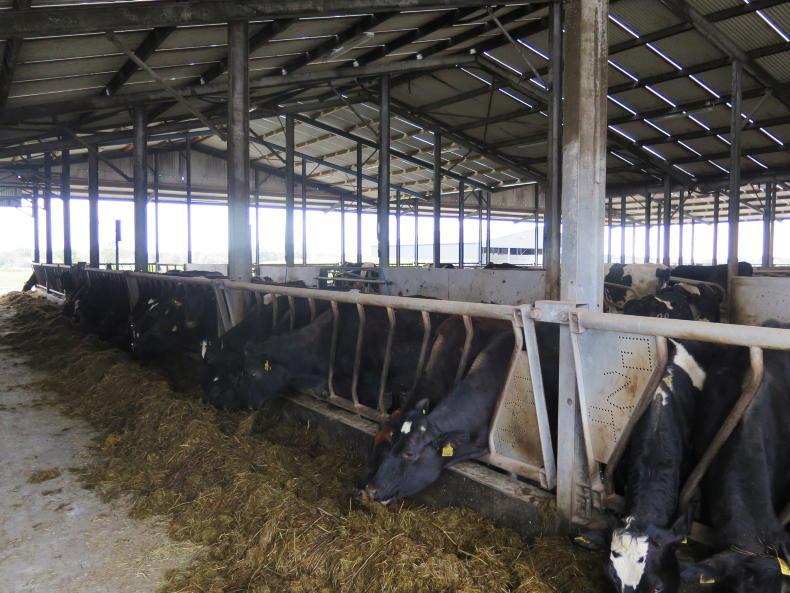
The cubicle shed has space for 200 cows.
The 54ha milking block was all reseeded and the existing slatted beef sheds were reconfigured and expanded to accommodate 200 cubicles and a new 26-unit Waikato milking parlour was built. The finish is exceptional and facilities and infrastructure, both in the yard and out the fields is excellent.

The 26-unit Waikato plant was installed in a greenfield parlour.
There’s about five months of slurry storage and all cubicles are roofed. Donal says that about one third of the land is on the heavier side but drainage, good roadways and plenty of access points make it much more manageable.
Calving
Calving has gone well, with 146 calved out of 205. There was one stillborn calf and a heifer lay down on another calf, but otherwise everything born alive is thankfully healthy and well. The only issue so far is that none of the bull calves have been sold yet so the sheds are getting full. The plan is to take the 20 best bull calves to the mart next week which will relieve the pressure.
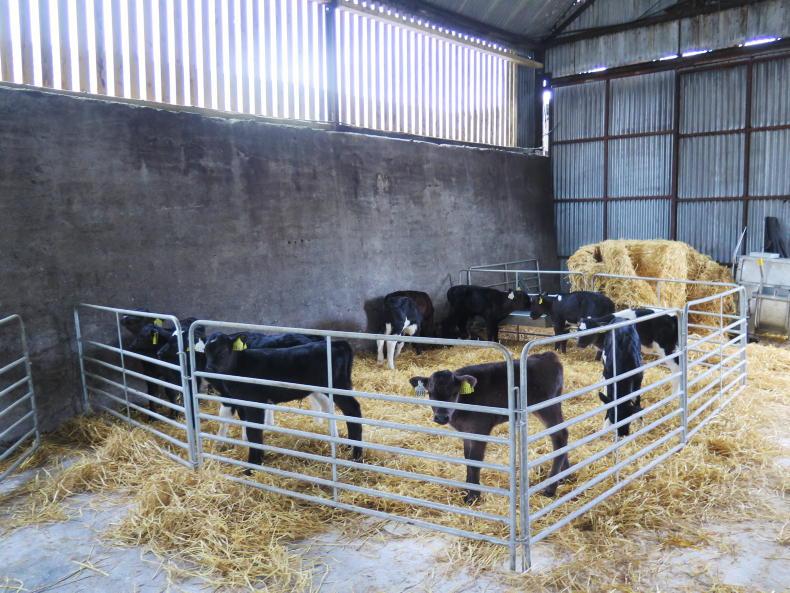
Baby calves are grouped together using sheep hurdles.
There is extra housing on the farm which can be used for calves if needs be but Donal would prefer to sell them rather than keep them for any longer. These calves will be touching four weeks of age and the best are over 50kg liveweight. The herd is Jersey crossbred so that is a factor in the local demand for calves from the farm.
Sexed semen
For next season, Donal’s plan is to use more sexed semen and more beef AI. He has already identified the 120 best cows in the herd and the first 60 of these that come bulling and are suitable for sexed semen (more than 60 days calved, have already cycled, good body condition score, 14 to 20 hours since onset of heat, etc) will get a sexed straw.
He has 40 maiden heifers and these will be served with sexed semen using fixed-time AI with a CIDR/coil. He has also purchased 40 conventional straws of the proven bull ZSP.
Based on a simple 50% conception rate to the 100 sexed semen straws being used, he should get 50 pregnancies of which 90% should be female, which amounts to 45 heifer calves. If the 40 conventional straws result in 10 heifer calves on the ground Donal will have more than enough heifer calves for his requirements.
What doesn’t get dairy AI will get Hereford or Angus AI and Angus stock bulls will be used after six weeks of breeding. With Liam still involved in beef farming on other land that is not part of the dairy enterprise, they have the option of keeping all the bull calves born on the farm and rearing these to beef.
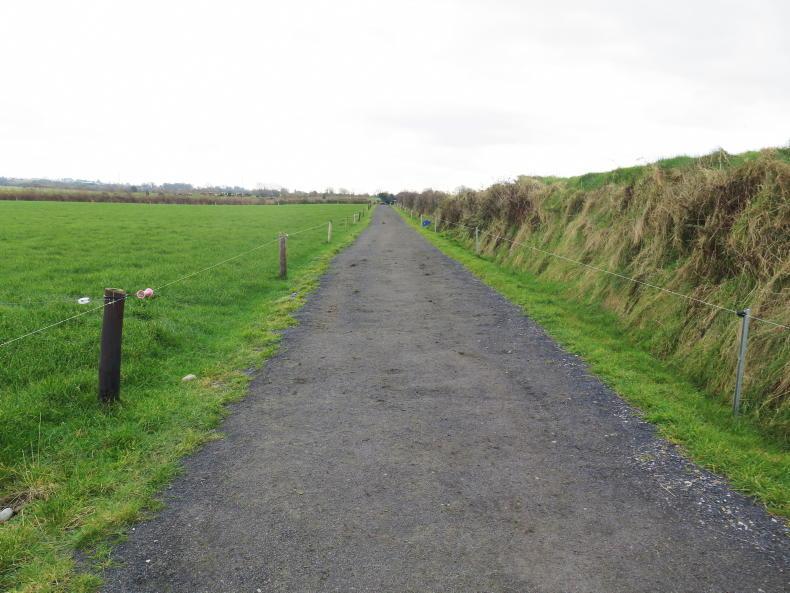
Roadways and grazing infrastructure is excellent.
Donal has no plans to move away from crossbreeding to generate herd replacements. Based on what he’s seen, he’s disappointed with the progeny performance of some of the young Holstein Friesian genomic bulls which dominate the AI catalogues: “I’ve seen the results of using high-EBI genomic bulls on good crossbred cows both on farms I’ve worked on and with members of my discussion group. I don’t like the progeny. I think they’re quite leggy and very tall and heavy. When you look at the milk recording results their dams outperformed them so you’re not actually making genetic progress with them, in fact it’s the opposite.
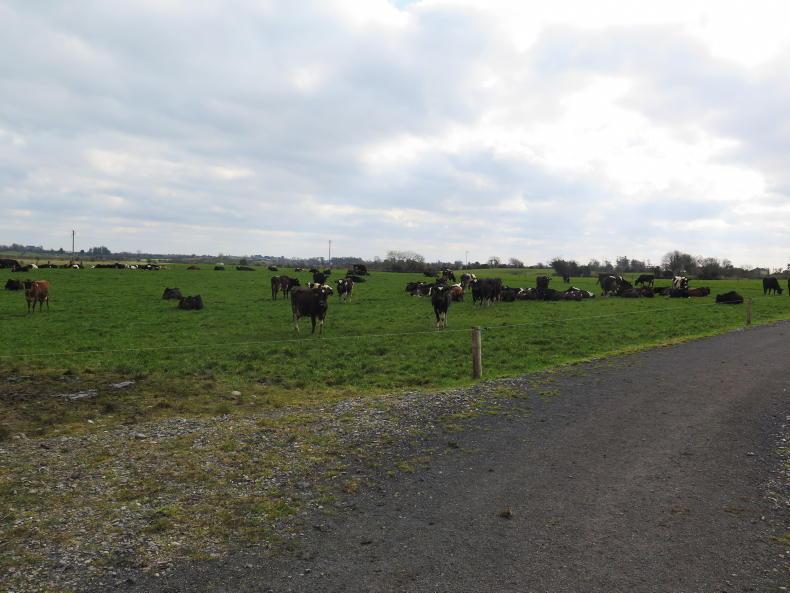
The herd is all second-calvers and are in good body condition score.
“You can pick high-EBI genomic Holstein Friesian bulls with a maintenance of €25 to €30 but you’re left with very few bulls to choose from. It’s hard to find compact-sized genomic bulls that will deliver percentages and yield. Using a pure Jersey bull on these cows isn’t the solution either as you’re left with too small an animal so I think using a high-EBI, daughter-proven crossbred bull is the best approach as it maintains the size you want in the cows and you’re certain of making real genetic gain.”
His own herd is nearly all second-calvers as all heifers were purchased in their first year. Performance last year was higher than expected at 386kg MS/cow (based on total output divided by peak cow numbers) from 850kg of meal per cow. Empty rate was 4.5% after 12 weeks of breeding.
His target is to feed 650kg of meal but Donal says he’s not afraid to feed more if they need it. With 54ha in the milking platform, the stocking rate is high at 3.8 cows/ha.
Grass
Average farm cover is extremely high at 1,400kg/ha so they are literally wading through grass. The closing cover was 860kg/ha last December. Donal says soil fertility is much better than they expected and when combined with a mild winter and the fact that all the farm was recently reseeded, growth rates are high.
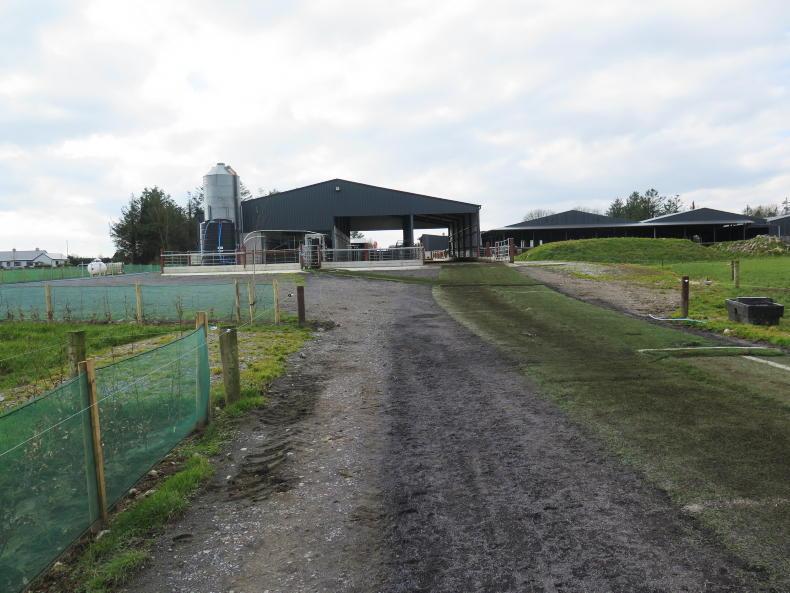
Astroturf has been laid near the milking parlour.
Donal spread 16 units/acre of urea across the milking platform at the end of January and the silage ground got 2,300 gallons/acre at the same time. The area that has been grazed will get slurry in the next few weeks and when the weather dries up again he plans to go with 25 to 30 units/acre of urea on the grazing ground. The plan with the silage ground, which is away from the platform, is to graze it once in the spring with the maiden heifers, take three cuts of silage and then graze it again in the autumn.

Permanent spur roads give access to the wetter parts of paddocks.
During this busy period Donal is on the farm every day. It’s a family farm with Liam and his children helping out at the weekends and Donal’s brother helping out at the weekends also. Transition year student Brian Hett is on the farm every Monday while a milker comes in for morning milking four days a week, plus a night calvers covers calving from 3am to 6am.
The conversion to dairy has kept Donal living and working in his home parish where not only has he got a job but a great career ahead of him all the while doing what he loves the most – farming. The farm is part of the Aurivo/Teagasc joint programme which has been a big support to Donal and Liam in their conversion.
Grazing got off to a slow start on Donal Ronayne’s farm near Claremorris in Co Mayo but has since ramped up dramatically.
Donal had 25% of the milking platform grazed by last Monday and was looking to get to 40% grazed as quickly as he could. This was before the heavy rain on Tuesday and Wednesday and ground conditions were perfect.
However, as we’ll see later, this is a farm that is well set up for early grazing.
Due date for the start of calving was 13 February but a handful of calves came before then. With a dry farm and good over-winter growth rates over the last few years, Donal is toying with the idea of bringing calving date forward a few days.
Last year was one of the lowest rainfall years in a long time but we still got 1,270mm of rain
Since calving started, only four days have been missed and now that over 70% of the herd has calved, Donal will try all he can to keep grass in the diet;
“I’m a big fan of on-off grazing and we use it a lot, both in the spring and in the autumn. We’ve a relatively dry farm but we’re in a high-rainfall area.
“Last year was one of the lowest rainfall years in a long time but we still got 1,270mm of rain.
“When we’re on-off grazing they’ll go to grass for a few hours and then they’ll go back to the shed with maybe a kilo or two of silage in front of them.
“We’re lucky that we got a lot of the lighter covers which were on some of the wetter land grazed off so what’s ahead of the cows now is heavier covers on drier land,” he says.
Donal farms in partnership with his uncle, Liam Trench. The pair have made huge changes to the farm over the last two years.
Liam, who runs a busy contracting business and continues to farm beef cattle on other land, used to keep up to 120 suckler cows on the home farm.
A company was set up with both Liam and Donal as the shareholders. Liam gets a lease payment for the land and Donal gets a management salary for running the farm
Donal, a graduate of the Dairy Business course at UCD, is from a drystock farm and has worked on dairy farms since graduating in 2017.
Together they set about converting the farm to a 200-cow dairy operation. A company was set up with both Liam and Donal as the shareholders. Liam gets a lease payment for the land and Donal gets a management salary for running the farm. The profits can either be used to re-invest in the farm, pay down debt or can be split between the two shareholders.

The cubicle shed has space for 200 cows.
The 54ha milking block was all reseeded and the existing slatted beef sheds were reconfigured and expanded to accommodate 200 cubicles and a new 26-unit Waikato milking parlour was built. The finish is exceptional and facilities and infrastructure, both in the yard and out the fields is excellent.

The 26-unit Waikato plant was installed in a greenfield parlour.
There’s about five months of slurry storage and all cubicles are roofed. Donal says that about one third of the land is on the heavier side but drainage, good roadways and plenty of access points make it much more manageable.
Calving
Calving has gone well, with 146 calved out of 205. There was one stillborn calf and a heifer lay down on another calf, but otherwise everything born alive is thankfully healthy and well. The only issue so far is that none of the bull calves have been sold yet so the sheds are getting full. The plan is to take the 20 best bull calves to the mart next week which will relieve the pressure.

Baby calves are grouped together using sheep hurdles.
There is extra housing on the farm which can be used for calves if needs be but Donal would prefer to sell them rather than keep them for any longer. These calves will be touching four weeks of age and the best are over 50kg liveweight. The herd is Jersey crossbred so that is a factor in the local demand for calves from the farm.
Sexed semen
For next season, Donal’s plan is to use more sexed semen and more beef AI. He has already identified the 120 best cows in the herd and the first 60 of these that come bulling and are suitable for sexed semen (more than 60 days calved, have already cycled, good body condition score, 14 to 20 hours since onset of heat, etc) will get a sexed straw.
He has 40 maiden heifers and these will be served with sexed semen using fixed-time AI with a CIDR/coil. He has also purchased 40 conventional straws of the proven bull ZSP.
Based on a simple 50% conception rate to the 100 sexed semen straws being used, he should get 50 pregnancies of which 90% should be female, which amounts to 45 heifer calves. If the 40 conventional straws result in 10 heifer calves on the ground Donal will have more than enough heifer calves for his requirements.
What doesn’t get dairy AI will get Hereford or Angus AI and Angus stock bulls will be used after six weeks of breeding. With Liam still involved in beef farming on other land that is not part of the dairy enterprise, they have the option of keeping all the bull calves born on the farm and rearing these to beef.

Roadways and grazing infrastructure is excellent.
Donal has no plans to move away from crossbreeding to generate herd replacements. Based on what he’s seen, he’s disappointed with the progeny performance of some of the young Holstein Friesian genomic bulls which dominate the AI catalogues: “I’ve seen the results of using high-EBI genomic bulls on good crossbred cows both on farms I’ve worked on and with members of my discussion group. I don’t like the progeny. I think they’re quite leggy and very tall and heavy. When you look at the milk recording results their dams outperformed them so you’re not actually making genetic progress with them, in fact it’s the opposite.

The herd is all second-calvers and are in good body condition score.
“You can pick high-EBI genomic Holstein Friesian bulls with a maintenance of €25 to €30 but you’re left with very few bulls to choose from. It’s hard to find compact-sized genomic bulls that will deliver percentages and yield. Using a pure Jersey bull on these cows isn’t the solution either as you’re left with too small an animal so I think using a high-EBI, daughter-proven crossbred bull is the best approach as it maintains the size you want in the cows and you’re certain of making real genetic gain.”
His own herd is nearly all second-calvers as all heifers were purchased in their first year. Performance last year was higher than expected at 386kg MS/cow (based on total output divided by peak cow numbers) from 850kg of meal per cow. Empty rate was 4.5% after 12 weeks of breeding.
His target is to feed 650kg of meal but Donal says he’s not afraid to feed more if they need it. With 54ha in the milking platform, the stocking rate is high at 3.8 cows/ha.
Grass
Average farm cover is extremely high at 1,400kg/ha so they are literally wading through grass. The closing cover was 860kg/ha last December. Donal says soil fertility is much better than they expected and when combined with a mild winter and the fact that all the farm was recently reseeded, growth rates are high.

Astroturf has been laid near the milking parlour.
Donal spread 16 units/acre of urea across the milking platform at the end of January and the silage ground got 2,300 gallons/acre at the same time. The area that has been grazed will get slurry in the next few weeks and when the weather dries up again he plans to go with 25 to 30 units/acre of urea on the grazing ground. The plan with the silage ground, which is away from the platform, is to graze it once in the spring with the maiden heifers, take three cuts of silage and then graze it again in the autumn.

Permanent spur roads give access to the wetter parts of paddocks.
During this busy period Donal is on the farm every day. It’s a family farm with Liam and his children helping out at the weekends and Donal’s brother helping out at the weekends also. Transition year student Brian Hett is on the farm every Monday while a milker comes in for morning milking four days a week, plus a night calvers covers calving from 3am to 6am.
The conversion to dairy has kept Donal living and working in his home parish where not only has he got a job but a great career ahead of him all the while doing what he loves the most – farming. The farm is part of the Aurivo/Teagasc joint programme which has been a big support to Donal and Liam in their conversion.













 This is a subscriber-only article
This is a subscriber-only article










SHARING OPTIONS: